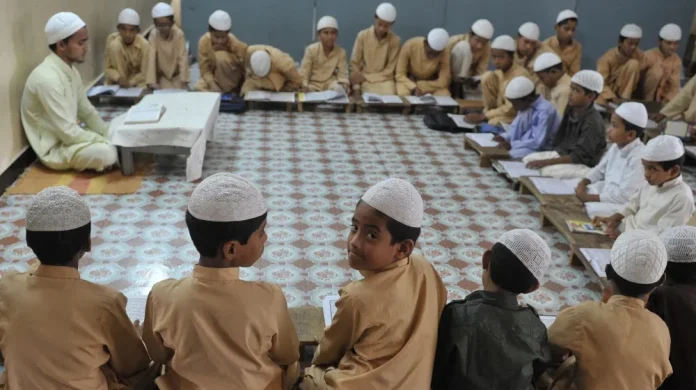– Abdul Bari Masoud
“Reform,” “modernisation,” “child welfare” – these are the official slogans under which madrasas are being surveyed, defunded, shut down, and, in some cases, demolished across several BJP-ruled states. But critics, educators, and civil society leaders warn: this isn’t about education. It’s about erasure.
What began as state-level surveys and regulatory checks has evolved into a full-blown ideological campaign. Armed with legal notices, closures, and emotionally charged narratives, the state’s institutional machinery is increasingly turning its gaze on these traditional centres of Muslim learning.
A Systematic Pattern of Attack
From Assam to Uttar Pradesh, Madhya Pradesh to Uttarakhand, madrasas have come under relentless scrutiny in recent years. BJP-led state governments claim they are simply enforcing regulation, streamlining curricula, and protecting child rights. But the methods – sudden surveys, ambiguous legal notices, mass closures, and media demonisation – reveal a pattern far more complex, and far more chilling.
The BJP and its ideological parent, RSS, have long viewed madrasas as symbols of cultural autonomy that challenge the Hindutva nationalist vision of a homogenised Indian identity. To them, madrasas are not just educational institutions – they are fault lines in the project of Hindutva.
The role of state institutions in this process has grown. Leading this charge is the National Commission for Protection of Child Rights (NCPCR), which has evolved into an unlikely yet aggressive agent in the effort to delegitimise Islamic education.
NCPCR and the “Rights” Rhetoric
In 2022, NCPCR released a sharply worded report titled “Guardians of Faith or Oppressors of Rights?” – a document that sought to reframe the madrasa system not as an educational model, but as a potential violator of child rights.
The report made sweeping recommendations:
- Stop all state funding to madrasas.
- Dismantle madrasa boards across the country.
- Withdraw all non-Muslim students from madrasas.
- Mandate the transfer of Muslim students from madrasas to formal government or private schools.
The justification? That children studying in madrasas are being denied their Right to Education (RTE) and are subjected to “religious indoctrination” without informed parental consent.
More controversially, NCPCR alleged that children in some madrasas were being treated as “bonded labourers” – a claim that provoked outrage from Muslim scholars and education activists who viewed it as not only inflammatory, but deeply dehumanising.
The commission even pushed for mapping and background checks of madrasa students – especially those who were orphaned or from poor families – as though poverty and religion rendered them inherently suspect.
The Assam Template
In Assam, the government led by Himanta Biswa Sarma has been particularly zealous. The state’s Madrassa Education Board was dissolved in 2022 which was established during the British period, and 610 government-run madrasas were converted into upper primary and secondary schools. The move was justified as a way to “ensure secularism” in education.
But it didn’t stop there. Several private madrasas were demolished, often under the guise of being “illegal constructions” or based on unsubstantiated claims of links to “jihadi” groups. These allegations, rarely proven, were amplified by local media and used to legitimise aggressive actions.
Today, over 1,000 private madrasas remain in Assam, functioning under the curriculum set by All Assam Tanzim Madaris Qawmiya (AATMQ). But their future remains uncertain.
Uttar Pradesh: Compliance or Closure
In Uttar Pradesh, a massive survey of unregistered madrasas was ordered in 2022. The administration warned of potential closure unless these institutions registered with the state and adopted prescribed curricula.
Many feared that registration was a Trojan horse – an entry point for increased interference, surveillance, and eventually, control over hiring, syllabus, and religious content. The rhetoric used by officials – referring to madrasas as “breeding grounds” or “unsafe spaces” – only reinforced those fears.
What is striking is the lack of a similar campaign against other informal or religious schools run by Hindu groups – such as gurukuls, mutts, or ashram shalas. These institutions, many of which lack regulation or formal curricula, are seldom surveyed or publicly critiqued.
Madhya Pradesh: “Welfare” Surveillance
In Madhya Pradesh, NCPCR flagged over 9,000 madrasas for operating without adequate regulation. The commission called for detailed student profiles, welfare inspections, and integration of these students into state-monitored frameworks.
Activists say this approach amounts to institutionalised profiling. “This isn’t welfare. It’s surveillance,” said a madrasa teacher in Bhopal who asked not to be named. “They come in with cameras, ask children their religion, and question the staff like we’re criminals. Is this what they do in gurukuls too?”
A Constitutional Breach?
The campaign against madrasas has raised fundamental questions about Article 30 of the Indian Constitution, which guarantees minorities the right to establish and administer their own educational institutions.
For decades, madrasas have served as vital educational spaces for economically disadvantaged Muslims, especially in rural and semi-urban areas. Many offer food, lodging, and basic literacy in addition to religious instruction. While calls for curricular reform are not new – and have often come from within the Muslim community – the current state-led actions are coercive, not consultative.
“Reforms should not come from bulldozers and threats,” said Maulana Khalid Saifullah Rahmani, president of the All India Muslim Personal Law Board (AIMPLB). “They should come from engagement, funding, and partnership.”
Parallel Realities: Two Sets of Rules?
The central critique of the anti-madrasa campaign lies in its selective application of concern.
Why are madrasas positioned as problematic when thousands of Hindu religious schools operate outside regulation? Why is religious instruction deemed indoctrination only when it is Islamic?
“This is not about child rights,” said Jignesh Mevani, Congress MLA and activist. “This is about pushing a single national identity. They want Manusmriti, not the Constitution, to guide education policy.”
The RSS vision of ‘One Nation, One Culture’ inevitably sees pluralism as a threat. And so institutions like madrasas, which represent linguistic, religious, and cultural differences, become targets of cultural realignment.
Historical Context
Madrasas have existed in the subcontinent for centuries, dating back to the Delhi Sultanate and Mughal periods. British colonialists attempted to marginalise them, yet they remained centres of resistance, learning, and cultural preservation.
Post-Independence, madrasas continued to function under diverse boards – some recognised, some private – and filled the education vacuum left by a state that failed to reach every poor Muslim child.
By 2006, the Sachar Committee Report painted a bleak picture: Muslims had worse socio-economic and educational indicators than even Scheduled Castes. The report urged the government to invest in modernising madrasas, not dismantling them.
But the current BJP approach is not to modernise – it is to neutralise.
Undermining a Lifeline
For many poor Muslims, madrasas are not just schools – they are lifelines. They provide food, shelter, basic literacy, and spiritual education. In a country where over 12 million Muslim children remain out of formal schooling, and where Muslim educational backwardness has been repeatedly highlighted – from the Sachar Committee report (2006) to UDISE 2021-22 and a 2015 survey revealed that Muslims made up 25% of all out-of-school children in India – this crackdown threatens to further marginalise a vulnerable population.
As Congress leader Rahul Gandhi put it, “The BJP-RSS doesn’t want poor children to get English education because it teaches them to ask questions.”
Instead of addressing this educational gap, the state seems intent on eroding one of the few functioning alternatives available to the community.
“Yes, some madrasas need reform. But dismantling the entire structure without providing alternatives is not reform – it is exclusion masquerading as policy,” said Dr. Zoya Hasan, former JNU professor and political analyst.
Cultural Engineering
The targeting of madrasas is part of a broader ideological effort to reshape India’s national identity along Hindu majoritarian lines.
The signs are all around us as textbooks rewritten to downplay Muslim contributions, madrasa defunded, Urdu delegitimised in academia and state institutions. Similarly, interfaith relationships were criminalised under “love jihad” laws as well as Muslim festivals policed, and public religious practices restricted. Furthermore, names of cities, roads, and landmarks with Islamic origins changed to “restore pre-Muslim heritage”.
The real question facing India is not whether madrasas need reform. Most agree that they do – just as all education systems require evolution. The question is: who gets to lead that reform, and whose vision of India will it serve?
The campaign against madrasas – while couched in the language of reform, security, and child welfare – is deeply embedded in a political project to redefine Indian identity. It is not simply about improving education; it’s about recasting the national narrative, replacing pluralism with cultural uniformity.
In this fight over syllabi and school buildings lies something far more consequential: the future of secularism, minority rights, and India’s democratic soul.
The current state-led offensive against madrasas is not rooted in dialogue, development, or data. It is ideological warfare by other means – a fight not for better education, but for cultural supremacy.




